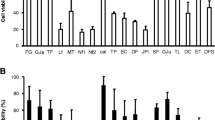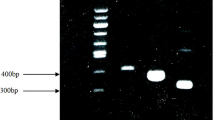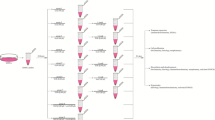Abstract
Purpose
Our aim was to study the effect of three-dimensional (3D) environment and overexpression of human fibroblast growth factor 2 (FGF-2) on meniscal fibrochondrocytes in vitro.
Methods
Human meniscal fibrochondrocytes were transfected with expression plasmid vectors carrying the Photinus pyralis luciferase gene, the Escherichia coli β-galactosidase gene or a human FGF-2 cDNA. Modified fibrochondrocytes were cultivated in 3D alginate hydrogel or cell pellets or in 2D monolayer culture.
Results
The levels of luciferase activity showed a peak at day two and returned to baseline levels by day 11, regardless of the type of cultivation. Both 3D environments supported the secretion of human FGF-2 protein upon FGF-2 transfection. Overexpression of human FGF-2 by genetically modified human meniscal fibrochondrocytes stimulated proliferation but not glycosaminoglycan synthesis only in 3D culture. Culture in alginate spheres resulted in a larger difference in cell numbers compared with pellet cultures.
Conclusions
Three-dimensional alginate spheres are well suited for the culture of genetically modified human meniscal fibrochondrocytes. These data are of value for cell-based approaches to meniscal repair using genetically modified human meniscal fibrochondrocytes overexpressing human FGF-2.





Similar content being viewed by others
References
Ballyns JJ, Wright TM, Bonassar LJ (2010) Effect of media mixing on ECM assembly and mechanical properties of anatomically-shaped tissue engineered meniscus. Biomaterials 31(26):6756–6763. doi:10.1016/j.biomaterials.2010.05.039
Chatain F, Robinson AH, Adeleine P, Chambat P, Neyret P (2001) The natural history of the knee following arthroscopic medial meniscectomy. Knee Surg Sports Traumatol Arthrosc 9(1):15–18
Cucchiarini M, Ekici M, Schetting S, Kohn D, Madry H (2011) Metabolic activities and chondrogenic differentiation of human mesenchymal stem cells following recombinant adeno-associated virus-mediated gene transfer and overexpression of fibroblast growth factor 2. Tissue Eng Part A 17(15–16):1921–1933. doi:10.1089/ten.TEA.2011.0018
Cucchiarini M, Schetting S, Terwilliger EF, Kohn D, Madry H (2009) rAAV-mediated overexpression of FGF-2 promotes cell proliferation, survival, and alpha-SMA expression in human meniscal lesions. Gene Ther 16(11):1363–1372. doi:10.1038/gt.2009.91
Dinser R, Kreppel F, Zaucke F, Blank C, Paulsson M, Kochanek S, Maurer P (2001) Comparison of long-term transgene expression after non-viral and adenoviral gene transfer into primary articular chondrocytes. Histochem Cell Biol 116(1):69–77
Englund M, Guermazi A, Lohmander LS (2009) The meniscus in knee osteoarthritis. Rheum Dis Clin North Am 35(3):579–590. doi:10.1016/j.rdc.2009.08.004
Evans CH, Ghivizzani SC, Robbins PD (2004) Orthopaedic gene therapy. Clin Orthop 429:316–329
Garg T, Singh O, Arora S, Murthy R (2012) Scaffold: a novel carrier for cell and drug delivery. Crit Rev Ther Drug Carrier Syst 29(1):1–63
Heiligenstein S, Cucchiarini M, Laschke MW, Bohle RM, Kohn D, Menger MD, Madry H (2011) Evaluation of nonbiomedical and biomedical grade alginates for the transplantation of genetically modified articular chondrocytes to cartilage defects in a large animal model in vivo. J Gene Med 13(4):230–242. doi:10.1002/jgm.1557
Heiligenstein S, Cucchiarini M, Laschke MW, Bohle RM, Kohn D, Menger MD, Madry H (2011) In vitro and in vivo characterization of nonbiomedical- and biomedical-grade alginates for articular chondrocyte transplantation. Tissue Eng Part C Methods 17(8):829–842. doi:10.1089/ten.tec.2010.0681
Kaul G, Cucchiarini M, Arntzen D, Zurakowski D, Menger MD, Kohn D, Trippel SB, Madry H (2006) Local stimulation of articular cartilage repair by transplantation of encapsulated chondrocytes overexpressing human fibroblast growth factor 2 (FGF-2) in vivo. J Gene Med 8(1):100–111
Lee HP, Kaul G, Cucchiarini M, Madry H (2014) Nonviral gene transfer to human meniscal cells. Part I: transfection analyses and cell transplantation to meniscus explants. Int Orthop (submitted)
Madry H, Emkey G, Zurakowski D, Trippel SB (2004) Overexpression of human fibroblast growth factor 2 stimulates cell proliferation in an ex vivo model of articular chondrocyte transplantation. J Gene Med 6(2):238–245
Madry H, Kaul G, Cucchiarini M, Stein U, Zurakowski D, Remberger K, Menger MD, Kohn D, Trippel SB (2005) Enhanced repair of articular cartilage defects in vivo by transplanted chondrocytes overexpressing insulin-like growth factor I (IGF-I). Gene Ther 12(14):1171–1179
Madry H, Padera R, Seidel J, Langer R, Freed LE, Trippel SB, Vunjak-Novakovic G (2002) Gene transfer of a human insulin-like growth factor I cDNA enhances tissue engineering of cartilage. Hum Gene Ther 13(13):1621–1630
Madry H, Rey-Rico A, Venkatesan JK, Johnstone B, Cucchiarini M (2013) Transforming growth factor Beta-releasing scaffolds for cartilage tissue engineering. Tissue Eng Part B Rev 20(2):106–125. doi:10.1089/ten.TEB.2013.0271
Madry H, Trippel SB (2000) Efficient lipid-mediated gene transfer to articular chondrocytes. Gene Ther 7(4):286–291
Madry H, Zurakowski D, Trippel SB (2001) Overexpression of human insulin-like growth factor-I promotes new tissue formation in an ex vivo model of articular chondrocyte transplantation. Gene Ther 8(19):1443–1449
Matthies NF, Mulet-Sierra A, Jomha NM, Adesida AB (2013) Matrix formation is enhanced in co-cultures of human meniscus cells with bone marrow stromal cells. J Tissue Eng Regen Med 7(12):965–973. doi:10.1002/term.1489
McDermott ID, Amis AA (2006) The consequences of meniscectomy. J Bone Joint Surg Br 88(12):1549–1556. doi:10.1302/0301-620X.88B12.18140
Narita A, Takahara M, Ogino T, Fukushima S, Kimura Y, Tabata Y (2009) Effect of gelatin hydrogel incorporating fibroblast growth factor 2 on human meniscal cells in an organ culture model. Knee 16(4):285–289. doi:10.1016/j.knee.2008.12.011
Narita A, Takahara M, Sato D, Ogino T, Fukushima S, Kimura Y, Tabata Y (2012) Biodegradable gelatin hydrogels incorporating fibroblast growth factor 2 promote healing of horizontal tears in rabbit meniscus. Arthroscopy 28(2):255–263. doi:10.1016/j.arthro.2011.08.294
Orth P, Weimer A, Kaul G, Kohn D, Cucchiarini M, Madry H (2008) Analysis of novel nonviral gene transfer systems for gene delivery to cells of the musculoskeletal system. Mol Biotechnol 38(2):137–144
Rey-Rico A, Silva M, Couceiro J, Concheiro A, Alvarez-Lorenzo C (2011) Osteogenic efficiency of in situ gelling poloxamine systems with and without bone morphogenetic protein-2. Eur Cell Mater 21:317–340
Verdonk PC, Forsyth RG, Wang J, Almqvist KF, Verdonk R, Veys EM, Verbruggen G (2005) Characterisation of human knee meniscus cell phenotype. Osteoarthritis Cartilage 13(7):548–560. doi:10.1016/j.joca.2005.01.010
Acknowledgment
We thank the members of the Department of Orthopaedic Surgery for providing human meniscal tissue.
Conflict of interest
The authors declare that they have no conflict of interest. The authors alone are responsible for the content and writing of the paper.
Authors’ contributions
HPL participated in the design of the study, carried out all studies and performed the statistical analysis. ARR participated in its design and draft. MC participated in the study design and draft. HM conceived and designed the study, co-ordinated it and drafted the manuscript. All authors read and approved the final manuscript.
Author information
Authors and Affiliations
Corresponding author
Additional information
Presented in part at the 55th Annual Meeting of the Orthopaedic Research Society, 2009, Las Vegas, NV, USA
Rights and permissions
About this article
Cite this article
Lee, HP., Rey-Rico, A., Cucchiarini, M. et al. Nonviral gene transfer into human meniscal cells. Part II: effect of three-dimensional environment and overexpression of human fibroblast growth factor 2. International Orthopaedics (SICOT) 38, 1931–1936 (2014). https://doi.org/10.1007/s00264-014-2405-z
Received:
Accepted:
Published:
Issue Date:
DOI: https://doi.org/10.1007/s00264-014-2405-z




